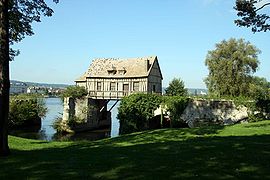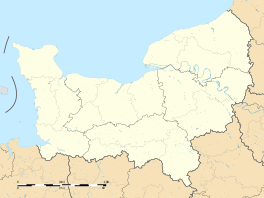Vernon, Eure
| Vernon | ||
|---|---|---|

Old mill on the broken bridge
|
||
|
||
| Coordinates: 49°05′N 1°29′E / 49.09°N 1.49°ECoordinates: 49°05′N 1°29′E / 49.09°N 1.49°E | ||
| Country | France | |
| Region | Normandy | |
| Department | Eure | |
| Arrondissement | Évreux | |
| Intercommunality | Portes de l'Eure | |
| Government | ||
| • Mayor (2008–2014) | Philippe Nguyen Thanh | |
| Area1 | 34.92 km2 (13.48 sq mi) | |
| Population (2008)2 | 24,998 | |
| • Density | 720/km2 (1,900/sq mi) | |
| Time zone | CET (UTC+1) | |
| • Summer (DST) | CEST (UTC+2) | |
| INSEE/Postal code | 27681 / 27200 | |
| Elevation | 10–148 m (33–486 ft) | |
|
1 French Land Register data, which excludes lakes, ponds, glaciers > 1 km² (0.386 sq mi or 247 acres) and river estuaries. 2Population without double counting: residents of multiple communes (e.g., students and military personnel) only counted once. |
||
1 French Land Register data, which excludes lakes, ponds, glaciers > 1 km² (0.386 sq mi or 247 acres) and river estuaries.
Vernon is a commune in the department of Eure in the Normandy region in northern France.
It lies on the banks of the Seine River, about midway between Paris and Rouen. The city is well known for its production of engines by the SNECMA group.
1027−1030 : Mention in a Latin written document as Vernum, the /m/ at the end could be the last remains of the Celtic magus 'plain' or 'market', or it is a simple latinization, and the origin is just the Celtic word *uerno, alder tree (Breton gwern, Welsh gwern, Irish fern).
The village gave its name to a family who took part to the Norman Conquest of England and then became a British first name.
Vernon is twinned with:
Collégiale Notre-Dame (now Parish Church)
Tour des archives (Philippe Auguste's Keep)
Maison du Temps Jadis (Medieval House)
Corner of Rue du Pont and Rue Carnot
Museum
Place Barette
Hôtel de ville (Town Hall)
Tomb of Saint-Mauxe
War memorial
Pont Clemenceau
Medieval bridge
Place Charles de Gaulle's Market Day
Espace Philippe-Auguste Culture Centre
...
Wikipedia



